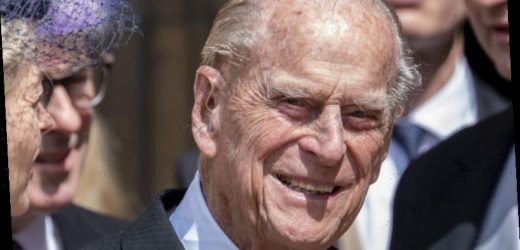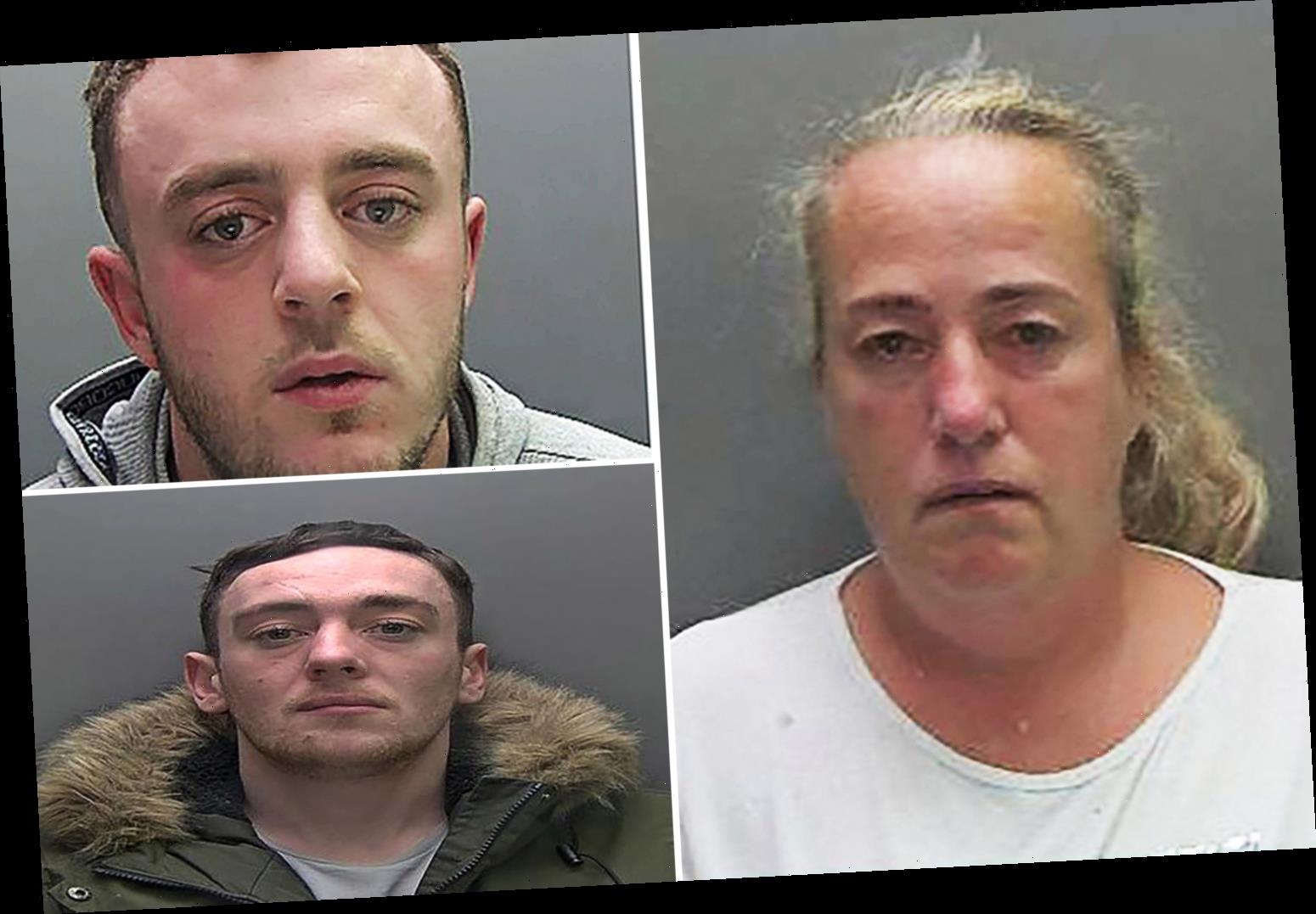PRINCE PHILIP, DUKE of EDINBURGH: 10 June 1921 – 9 April, 2021
No member of the royal family has visited Australia as often as Prince Philip. Over 71 years, from his first visit to Sydney in 1940 to his last in 2011, he seemed to enjoy his encounters – with his throwaway lines and sharp asides – and Australians, for their part, seemed to appreciate that irreverent directness.
Prince Philip at the wedding of Lady Gabriella Windsor in May 2019.Credit:Getty
His first visit was to Sydney in 1940, when he was a 19-year-old junior officer with HMS Ramillies. He proved a popular party guest. But he was never pretentious. When Sydney man-about-town, Marcel Dekyvere, was introduced by a friend to this young British sailor – “Meet Philip of Greece” — he snapped back, “Yes, and I’m Louis of France.” In 1942, he returned, a golden-bearded sub-lieutenant with the destroyer HMS Wallace.
The next time he visited was for the royal tour of 1954. It is said that three-quarters of the country’s population of 9 million saw the Queen and Duke in 1954.
They visited 70 towns in 58 days. It must have been hell. Inevitably the mayor would greet, accompany and sit beside the Queen. She confided in Patricia Mountbatten, “All these mayors are so boring. Why are they so boring?”
And it was Philip who would buck her up and try to make her smile. He recalled these early years, “The level of adulation, you wouldn’t believe it. It could have been corroding. It would have been very easy to play to the gallery but I took a conscious decision not to do that. Safer not to be too popular. You can’t fall too far.” Here, perhaps, is the key to the longevity of their marriage and the success of the Queen’s reign.
Queen Elizabeth II and Prince Philip during the royal visit to Australia in 1954.Credit:Fairfax
Philip returned two years after that triumph to open the Olympic Games in Melbourne. He seemed nonplussed by the athletes from communist countries who resisted saluting (presumably on instruction) as they passed the royal box. He was here for a month and took in both territories and NSW. In the Northern Territory, he bought 16 paintings by Aboriginal artists, including Albert and Oscar Namatjira and Henoch Raberaba. In 2013 Albert Namatjira’s grandchildren were welcomed to the Palace and presented their own paintings to add to the royal collection, which by then had works by Sidney Nolan, Clifton Pugh, Donald Friend, William Dobel and Olga Clare Garner.
In 1967 and 1968, he brought his Commonwealth Study Conference to Australia. In 1962 in Perth and 1982 in Brisbane, he opened the Commonwealth Games.
On one of his last visits, he was a guest of then-governor-general Quentin Bryce at Yarralumla. She showed Philip a photograph of Ilfracombe, her beloved home town, waxing lyrical about the wide horizon and the grassed plains; only to hear him say, “If you ask me, it looks ready for development.”
The Queen talks to governor-general Quentin Bryce and Prince Philip after she toured the Government House gardens in Canberra and planted a tree, in October 2011.Credit:Andrew Meares
From where had this extraordinary prince sprung? He was born on a table at Mon Repos (ironic for one so restless), the summer royal residence on the Ionian island of Corfu, the fifth child and only son of Prince Andrew of Greece and Princess Alice of Battenberg.
Andrew was the son of George I of Greece and descended from Nicholas I of Russia and Christian IX of Denmark. Alice was a great-granddaughter of Queen Victoria, niece of the last tsarina, and sister of the Queen of Sweden. An intelligent, forceful, amusing and brave woman, Alice was congenitally deaf and could not communicate with her children until they could speak when she could lip read.
Within 18 months the family had to flee (baby Philip in an orange box) as a death warrant was passed on Andrew by a Greek revolutionary court for a botched military operation. They settled at St Saint-Cloud, just out of Paris, in a house provided by Philip's aunt, Marie Bonaparte. The family kept in touch with their royal kin. As a small child Philip had taken tea with Queen Mary who described him as "a nice little boy with very blue eyes". Those eyes were to stand him in good stead.
Their years in exile took their toll and by 1930, Philip's parents had separated. Alice had suffered a mental breakdown, later diagnosed as paranoid schizophrenia, and was confined to a Swiss sanatorium. Andrew soon drifted off to Monte Carlo where he died in 1944. Philip retained a devotion to him and would wear his father's signet ring for the rest of his life. Philip left the American school at Saint-Cloud for the English prep school Cheam and then to Salem in Baden, a school owned by a brother-in-law and run by the legendary Kurt Hahn.
Prince Philip of Greece, later the Duke of Edinburgh, as a toddler in July 1922. Credit:Getty
When in 1934 Hahn moved to Scotland to escape Hitler and established Gordonstoun, Philip followed him. He thrived in this Spartan environment – early starts, freezing showers, cross-country runs (and would submit his three sons to the same). Holidays from school were spent in the schlosses and castles of his adoring sisters (all of whom married German princelings in 1930 and 1931), while in England both his maternal uncles, George, Marquess of Milford Haven, and Lord Louis Mountbatten, took him in.
As Ben Pimlott, the Queen’s best biographer, put it, “There was a confusion: uncertainty, neglect, and the feeling of being special mixed together.” One cousin said he gave the impression of “a huge, hungry dog, perhaps a friendly collie who… had never had a basket of his own”. A few years later, he recorded in a visitors’ book in Australia, “Whither the storm carries me, I go – a willing guest.”
In 1938, George Milford Haven died and his brother, Louis (Uncle Dickie), like the First Sea Lord he would become, steered his nephew resolutely towards eminence. In 1939, Philip joined the Royal Naval College, Dartmouth, as a Special Entry Cadet. His first significant encounter with his future wife came two months later, in July 1939, just before the outbreak of war, when the princess and her parents visited Dartmouth.
He made quite an impression, certainly among the princess’s circle who would sing, “Oh come to my arms, thou bundle of charms, Philip Mountbatten RN.”
Prince Philip at dinner with then-prime minister Robert Menzies. The duke was in Melbourne to open the Olympic Games in 1956.Credit:Fairfax
He had a distinguished war. Not long ago at a Buckingham Palace reception, Philip, in a truculent mood, asked Labour MP Andy Burnham what he had done before entering Parliament. Burnham confessed he had been a political adviser. Philip shot back with, “So, bugger all then?” Burnham then impudently asked, “What did you do before your marriage, sir?” Philip replied: “I fought in the Second World War.”
After escorting contingents of troops from Australia to the Middle East, he was involved in several engagements in the Mediterranean. In the battle of Matapan, he controlled the searchlights of his ship and was mentioned in dispatches. His captain reported, “Thanks to his alertness and appreciation of the situation, we were able to sink in five minutes two eight-inch-gun Italian cruisers.”
In October 1942, at 21, he was made a First Lieutenant and second-in-command of a destroyer. By mid-1943 he was aboard HMS Wallace off the coast of Sicily, possibly bombarding one of his German brothers-in-law. In July 1944, his ship was sent to the Pacific, where he remained until the Japanese surrender. Meanwhile, as Pimlott observed, “It is hard to think of an experience further removed than that of the Heiress Presumptive, in her castellated classroom.”
Despite being the Supreme Allied Commander of South East Asia, Uncle Dickie found time to pledge his nephew’s troth. He did not need to and Philip at least once remonstrated with his uncle to ease off. There is no doubt of the princess’ feelings. By 1946, her governess, Marion Crawford, reported that Elizabeth was incessantly playing People Will Say We’re in Love from the musical Oklahoma.
Princess Elizabeth, now Britain’s Queen Elizabeth II, and Lieutenant Philip Mountbatten, now Prince Philip, at Buckingham Palace after their wedding on November 20, 1947.Credit:AP
Not so enamoured, the Queen Mother had apparently drawn up a cricket 11 of possible husbands – suitable members of Britain’s high aristocracy. Philip was not among them. But the princess was determined and love won out. In March 1947, Philip shed his embarrassingly German family name of Schleswig-Holstein-Sonderburg-Glucksberg (and his not-so-distant claim to the Greek throne) and became naturalised as Lieutenant Philip Mountbatten. It seemed the naturalisation was completely unnecessary – according to a later Lord Chancellor, Lord Dilhorne – as a descendant of the Electress Sophia of Hanover, Philip had been British from birth.
By November 20, 1947, the wedding day, Philip had become Baron Greenwich, Earl of Merioneth, Duke of Edinburgh, a Knight of the Garter; he’d converted to Anglicanism and acquired a detective, a valet and a wardrobe to replace his few, meagre much-darned hand-me-downs. The government of Queensland gifted the bride and groom 500 cans of Golden Circle pineapples. Seven decades of service as consort were before him.
The young couple’s two years in Malta, where Philip had his first – and last – command, would be remembered as idyllic. Here they felt almost like any other naval officer and his wife. The princess had produced an heir, Charles, within 12 months of marriage and a daughter, Anne, less than two years later. But by 1951, George VI’s health meant a return to England and an end to Philip’s dream of being First Sea Lord. In February 1952, in their first major deputation, they set off for Australia via Kenya when the King died in his sleep at Sandringham. Elizabeth now found herself – in the words of another biographer, Gyles Brandreth – “married not only to Philip but also to those infinitely more demanding spouses, Britain, the Commonwealth and the Empire”.
Lieutenant Philip Mountbatten, husband of then princess Elizabeth resumes his attendance at the Royal Naval Officers’ School at Kingsmoor in Hawthorn, Wiltshire, in 1947. Credit:Getty Images
The first few years of Elizabeth’s reign were challenging ones for her consort, who would never be Prince Consort. They had to abandon Clarence House, which he had made home – in fact the first home he ever had – for the chilly grandeur of Buckingham Palace. Neither an Old Etonian nor a Guardsman, he also had to contend with the suspicion and disdain of the Queen’s courtiers: “Is he Greek? Is he Danish? Is he German?” Bemused, he would remind them that his mother had been born at Windsor Castle (as had his grandmother). He was also wounded by the government’s decision to deny his children their father’s name. “I’m just a bloody amoeba,” was his response; but his suggestion that the House of Windsor (which only about 30 years earlier had been Saxe-Coburg-Gotha) should become the House of Edinburgh, was curious.
And so he carved out a life and career in parallel. Yet his mantra was, and remained, that his role was to support the Queen. At every key moment in her reign, he was beside her. Well, three paces behind her – but the fact is that he was always there.
He is estimated to have made seven speeches a month for 60 years. He was founder, fellow, patron, president, chairman or member of about 837 organisations. Perhaps his most spectacular achievement is The Duke of Edinburgh’s Award, established in 1956 and now in 140 countries with more than 8 million young participants – 700,000 of them Australians. Other notable associations included the World Wildlife Fund, the National Playing Fields Association and the Commonwealth Study Conferences.
Brandreth says the only way Philip could stay alive and interested in the endless audiences, unveilings, walkabouts and line-ups – his life measured out in handshakes and small talk – was to stir and challenge those he met. He did not have his wife’s extraordinary control. In her Good Weekend profile, Sally Vincent put it differently. “Walking with his hands clasped behind his back and his neck thrust forward like a schoolmaster parading the classroom aisles looking for trouble. There was always someone or something to pick on.”
The gaffes – those one-liners that sustained him – cannot be overlooked. The Nigerian Secretary-General of the Commonwealth arriving at the Palace in full, splendidly colourful national dress was greeted with, “You look as if you’re ready for bed.” He said to an Ulsterwoman, “So, you managed to get here without having your knickers blown off?” And he greeted a wheelchair-bound woman wrapped in a foil blanket, “And now they’re going to put you in the oven?” And his clanger to Aboriginal leader William Brin at the Aboriginal Cultural Park in Cairns, “Do you still throw spears at each other?”
Prince Philip enjoying a beer at the Boags brewery in Launceston in 2000. Credit:Fairfax
There was a relentless need to be one up, especially with men, and he would never countenance losing an argument. Yet, he was never acquisitive. The only land he owned was a few acres at Wood Farm at Sandringham; and three cars – a Lagonda coupe, a converted London cab and a Land Rover Discovery.
Brandreth summed up the royal relationship as, “She wears the Crown; he wears the trousers.” Sovereignty aside, the Queen would leave it to Philip to make the decisions for the family. It was he who corresponded closely with prime minister Robert Menzies over the choice of Geelong Grammar for Charles.
And, years later, the mediation role the duke played as the first Wales marriage disintegrated was a revelation. His letters to Diana were direct, of course, but always signed “Pa” and full of sympathy, insight and affection. He expressed his amazement that Charles would prefer Camilla to Diana but reminded her that she, too, had had affairs. There was no sign here of the insensitive brute. He even tried a number of times with his second daughter-in-law, Sarah Ferguson, (the family appears to prefer correspondence to direct contact) but she proved incorrigible and he gave up.
His position on the monarchy’s future was stoic. Understandably perhaps – his Russian relatives were murdered three years before he was born; his cousin Constantine II of Greece had to flee his country in 1967. In Ottawa in 1969, as premier Pierre Trudeau chipped away at Canada’s royal connections, Philip bluntly observed, “I think it’s a complete misconception to imagine that the Monarchy exists in the interests of the Monarch – it doesn’t. It exists in the interests of the people: in a sense – we don’t come here for our health, so to speak. We can think of other ways of enjoying ourselves … I think that the important thing about it is that if, at any stage, people feel that it has no further part to play, then for goodness sake let’s end the thing on amicable terms without having a row about it.” He had said the same thing of Australia in 1967. “If the monarchy is of value, retain it … If not, get rid of it.”
Robert Lacey claims that Prince Philip’s immediate response to the outcome of the 1999 republic referendum was, “What’s the matter with these people? Can’t they see what’s good for them?”
This frankness might have annoyed monarchists but it must have appealed to many Australians as an admirable quality, the sort of trait we value – realistic, no-nonsense – quintessential Philip. And yet when then-prime minister Tony Abbott made the – admittedly anachronistic but surely harmless – gesture of making Philip a knight of the Order of Australia, the howls of outrage in the press and in Parliament were extraordinary. How mean-spirited and churlish they now appear.
Mark McGinness
Most Viewed in World
From our partners
Source: Read Full Article










